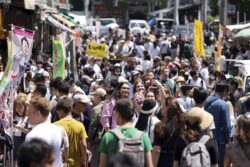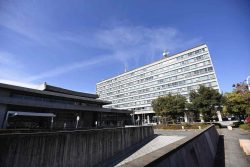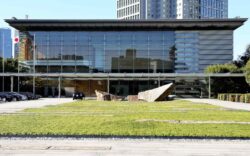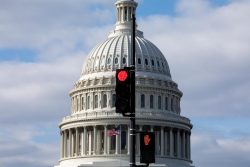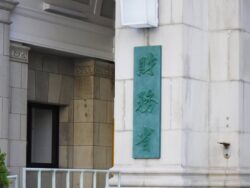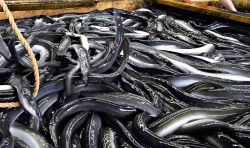Nankai Trough Earthquake: Utilize Damage Estimateto Help Mitigate Disaster
15:33 JST, April 2, 2025
There is a larger risk that a Nankai Trough earthquake, once it occurs, could cause unprecedented damage. It is essential for each member of the public to have a concrete image of what the earthquake could actually be like, and to use this picture in their disaster prevention measures.
The government has compiled a new estimate of damage for a possible megaquake originating in the Nankai Trough, which stretches from off the coast of Shizuoka Prefecture down to off the coast of Miyazaki Prefecture. A wide area along the Pacific coast would be hit by a tremor measuring a maximum 7 on the Japanese seismic intensity scale, and a tsunami would reach over 30 meters at its highest point.
If the earthquake occurs when multiple conditions are concurrently met, such as late on a winter night when many people are at home, and therefore evacuations are delayed, the death toll could reach more than 290,000, according to the estimate. Of these, over 210,000, or 70%, would be killed by the tsunami.
The probability of a Nankai Trough earthquake occurring in the next 30 years is said to be “around 80%.” These severe figures may cause some to say, “Residents will feel afraid” or “People will be discouraged from moving forward with disaster prevention measures.”
However, the figures vary significantly depending on the conditions. Rather than overreacting to them, it is important to calmly consider how they can be used in future disaster prevention measures.
For example, if all residents along the coastline began evacuating immediately after the earthquake occurred, the estimated number of fatalities from the tsunami would decrease from over 210,000 to over 70,000. Depending on individual awareness and actions, the actual damage can vary.
The improvement of infrastructure is also essential to steadily reduce the number of fatalities. The latest estimated number of fatalities is 25,000 people less than the over 320,000 in the previous estimate from 2012 to 2013. This is partly because houses based on the old earthquake-resistance standards have been rebuilt and tsunami evacuation facilities have been built.
Support for victims and reconstruction after the disaster will also be important issues. This time, the number of evacuees was estimated at 12.3 million and the economic damage at ¥292 trillion.
In April, the central government introduced a system of predetermining “immediate support prefectures” to dispatch support personnel to 10 prefectures where major damage is expected, including Aichi Prefecture. They are paired with other prefectures mainly on the Sea of Japan side and in the Tohoku region, such as Shizuoka-Toyama and Aichi-Fukushima.
If the support staff are not familiar with the geography of the afflicted areas, they will not be able to respond immediately. It is hoped that the designated local governments will share information with each other on a regular basis through joint training sessions and drills so that they can respond quickly.
The earthquake that struck Myanmar has caused extensive damage in neighboring Thailand as well, including the collapse of a building under construction. A Nankai Trough earthquake is also expected to cause prolonged ground motion that shakes high-rise buildings in the Tokyo metropolitan area and other locations far from the epicenter. Caution is required.
Disaster prevention and mitigation efforts should continue throughout Japan.
(From The Yomiuri Shimbun, April 2, 2025)
Related Tags
"Editorial & Columns" POPULAR ARTICLE
-

Violations of Subcontract Law: Major Automakers Must Eliminate Old Practices
-

Local Governments’ Tax Revenues: Devise Ways to Correct Imbalances in Tax Sources
-

5 Japanese Business Dinner Mistakes to Avoid — and What They Taught Me About Business in Japan
-

Heavy Rains in Asia: Support for Victims, Flood-Control Measures Urgently Needed
-

New Nuclear Threat: China Seeking to Follow U.S., Russia in Military Expansion
JN ACCESS RANKING
-

Keidanren Chairman Yoshinobu Tsutsui Visits Kashiwazaki-Kariwa Nuclear Power Plant; Inspects New Emergency Safety System
-
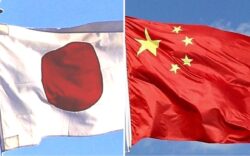
Imports of Rare Earths from China Facing Delays, May Be Caused by Deterioration of Japan-China Relations
-

University of Tokyo Professor Discusses Japanese Economic Security in Interview Ahead of Forum
-
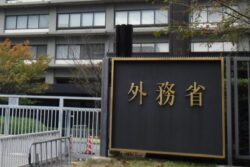
Japan Pulls out of Vietnam Nuclear Project, Complicating Hanoi’s Power Plans
-

Govt Aims to Expand NISA Program Lineup, Abolish Age Restriction











